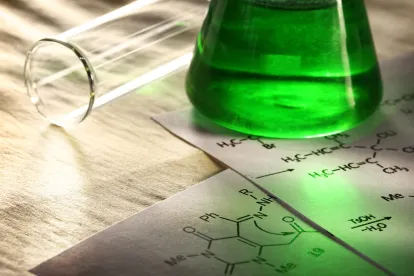In Allergan, Inc. v. Sandoz, Inc., the Federal Circuit affirmed the district court decision that upheld the validity of the Allergan patents relating to Lumigan® 0.01% glaucoma eye drops against obviousness, written description, and enablement challenges. I previously wrote about the obviousness analysis. Here, I look at the court’s discussion of the written description and enablement issues, and note its citation of prophetic examples.
The Lumigan Patent Claims At Issue
The claims challenged on written description and enablement grounds were claims 1, 7, and 8 of U.S. Patent No. 8,278,353, which recite compositions that achieve clinical paramaters:
1. A first composition administered once daily for lowering intraocular pressure in a person with glaucoma or ocular hypertension, the first composition comprising about 0.01% w/v bimatoprost and about 0.02% w/v benzalkonium chloride, wherein the first composition lowers intraocular pressure and results in less hyperemia as compared to the once daily administration of a second composition comprising 0.03% w/v bimatoprost and 0.005% w/v benzalkonium chloride.
Claim 7 is similar and recites that “the first composition lowers intraocular pressure without a substantial reduction in the intraocular pressure lowering benefit provided by the once daily administration of [the] second composition.”
Claim 8 depends from claim 7 and recites that “the once daily administration of the first composition results in less hyperemia as compared to the once daily administration of the second composition.”
The defendants challenged the written description and enablement of these claims because the specification “does not disclose any efficacy or hyperemia data of a formulation comprising 0.01% bimatoprost and 200 ppm BAK.”
Written Description Of Clinical Parameters Is Met By Disclosure Of A Composition That Inherently Achieves The Results
The Federal Circuit decision was authored by Judge Lourie and joined by Judges Linn and Hughes.
The Federal Circuit rejected the premise of the written description challenge:
The specifications specifically describe a formulation comprising 0.01% bimatoprost and 200 ppm BAK as one of the best modes of the invention. …. 67. The Group II claims all require the same amounts of bimatoprost and BAK. The specifications thus disclose the claimed formulation as characterized by those ingredients, and the skilled artisan would immediately discern the claimed formulation in that disclosure.
With regard to the clinical parameters, the Federal Circuit cited the defendants’ obviousness arguments that they were inherent to the formulation:
A claim that recites a property that is necessarily inherent in a formulation that is adequately described is not invalid as lacking written description merely because the property itself is not explicitly described.
Thus, the Federal Circuit affirmed the district court’s ruling that the claims were not invalid for lack of written description. However, the Federal Circuit did criticize the district court for relying on extrinsic evidence to support written description:
We do find, however, that the district court erred by relying on the undisclosed clinical protocol to support its written description determination. As we have explained, “[i]t is the disclosures of the applications that count.” Lockwood v. Am. Airlines, Inc., 107 F.3d 1565, 1571 (Fed.Cir. 1997). …. The written description requirement requires possession as shown in the specification, not as shown by prior experimental work.
Enablement Of Clinical Parameters Is Met By Disclosure Of How To Make And Use A Composition That Achieves The Results
The defendants also cited the lack of experimental data in the specification in support of their enablement challenge, taking the position that “if the claims are held to be nonobvious, then they must fail the enablement requirement because the district court found that ophthalmic formulation is unpredictable and that the prior art taught away from the claimed invention.” The Federal Circuit rejected that premise (emphasis added):
The obviousness inquiry turns on what the prior art would have taught a person of ordinary skill in the art and whether the claimed would have been obvious in view of the prior art. The enablement inquiry turns on whether the skilled artisan, after reading the specification, would be able to make and use the claimed invention without undue experimentation, based on the ordinary skill in the art.
As with its finding on written description, the Federal Circuit found that, in view of the disclosure of the claimed compositions together with constructive examples using 0.015% bimatoprost and 125 ppm BAK “the skilled artisan would not have questioned the utility of the claimed formulation and would be able to make and use the claimed invention without undue experimentation.” In this regard, the court emphasized:
A patent does not need to guarantee that the invention works for a claim to be enabled. And efficacy data are generally not required in a patent application. Only a sufficient description enabling a person of ordinary skill in the art to carry out an invention is needed.
Reliance On Prophetic Examples
I think the “constructive example” cited in the Federal Circuit decision is prophetic Example 5, which is reproduced in its entirety below:
EXAMPLE 5
A drop of formulation J is administered once daily topically to the eye of a person suffering from glaucoma. After a few hours, intraocular pressure drops more and less hyperemia is observed than would be observed for formulation A. Lowered intraocular pressure persists for as long as the treatment continues.
The specification includes data from animal studies showing that BAK increased the permeability of 0.015% bimatoprost formulations, but they did not study the effect on intraocular pressure or hyperemia.
This case thus serves as a reminder of the potential value of prophetic examples.




 />i
/>i

